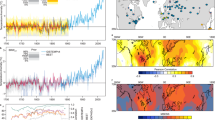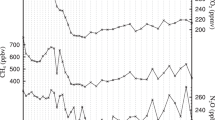Abstract
The average air temperature at the Earth's surface has increased by 0.06 °C per decade during the 20th century1, and by 0.19 °C per decade from 1979 to 19982. Climate models generally predict amplified warming in polar regions3,4, as observed in Antarctica's peninsula region over the second half of the 20th century5,6,7,8,9. Although previous reports suggest slight recent continental warming9,10, our spatial analysis of Antarctic meteorological data demonstrates a net cooling on the Antarctic continent between 1966 and 2000, particularly during summer and autumn. The McMurdo Dry Valleys have cooled by 0.7 °C per decade between 1986 and 2000, with similar pronounced seasonal trends. Summer cooling is particularly important to Antarctic terrestrial ecosystems that are poised at the interface of ice and water. Here we present data from the dry valleys representing evidence of rapid terrestrial ecosystem response to climate cooling in Antarctica, including decreased primary productivity of lakes (6–9% per year) and declining numbers of soil invertebrates (more than 10% per year). Continental Antarctic cooling, especially the seasonality of cooling, poses challenges to models of climate and ecosystem change.
This is a preview of subscription content, access via your institution
Access options
Subscribe to this journal
Receive 51 print issues and online access
$199.00 per year
only $3.90 per issue
Buy this article
- Purchase on Springer Link
- Instant access to full article PDF
Prices may be subject to local taxes which are calculated during checkout


Similar content being viewed by others
References
Houghton, J. T. et al. (eds) Climate Change 2001: The Scientific Basis. Intergovernmental Panel on Climate Change (Cambridge Univ. Press, Cambridge, 2001)
National Research Council Reconciling Observations of Global Temperature Change (National Academy Press, Washington DC, 2000)
Chen, C. T. A. & Drake, E. T. Carbon dioxide increase in the atmosphere and oceans and possible effects on climate. Annu. Rev. Earth Planet. Sci. 14, 201–235 (1986)
Cattle, H. & Crossley, J. Modeling arctic climate change. Phil. Trans. R. Soc. Lond. A 352, 201–213 (1995)
Weller, G. Regional impacts of climate change in the Arctic and Antarctic. Ann. Glaciol. 27, 543–552 (1998)
Vaughan, D. G. & Doake, C. S. M. Recent atmospheric warming and retreat of ice shelves on the Antarctic Peninsula. Nature 379, 328–331 (1996)
Comiso, J. C. Variability and trends in Antarctic surface temperatures from in situ and satellite infrared measurements. J. Clim. 13, 1674–1696 (2000)
Smith, R. C. et al. Marine ecosystem sensitivity to climate change. BioScience 49, 393–404 (1999)
Vaughan, D. G. et al. Devil in the detail. Science 293, 1777–1779 (2001)
Jacka, T. H. & Budd, W. F. Detection of temperature and sea-ice-extent changes in the Antarctic and Southern Ocean 1949–96. Ann. Glaciol. 27, 553–559 (1998)
Riordan, A. J. in Climate of the Arctic (eds Weller, G. & Bowling, S. A.) 268–275 (Geophysical Institute, University of Alaska, Fairbanks, 1973)
Bromley, A. M. Weather Observations, Wright Valley Antarctica Information Publication no. 11 (New Zealand Meteorological Service, Wellington, 1985)
Clow, G. D., McKay, C. P., Simmons, G. M. Jr & Wharton, R. A. Jr Climatological observations and predicted sublimation rates at Lake Hoare. Antarct. J. Clim. 1, 715–728 (1988)
McKay, C. P., Nienow, J. A., Meyer, M. A. & Friedmann, E. I. in Antarctic Meteorology and Climatology: Studies Based on Automatic Weather Stations Antarctic Research Series 61 (eds Bromwich, D. H. & Stearns, C. R.) 201–207 (American Geophysical Union, Washington DC, 1993)
Freckman, D. W. & Virginia, R. A. Low-diversity Antarctic soil nematode communities: distribution and response to disturbance. Ecology 78, 363–369 (1997)
Doran, P. T. et al. Climate observations (1986–2000) from the McMurdo Dry Valleys, Antarctica. J. Clim. (submitted).
Bromwich, D. H. & Parish, T. R. (eds) Antarctica: Barometer of Climate Change Report of the National Science Foundation Antarctic Meteorology Working Group (National Science Foundation, Arlington, Virginia, 1998).
Parish, T. R. & Cassano, J. J. Forcing of the wintertime Antarctic boundary layer winds from the NCEP-NCAR global reanalysis. J. Appl. Meteorol. 40, 810–821 (2001)
Wharton, R. A. et al. Changes in ice cover thickness and lake level of Lake Hoare, Antarctica—implications for local climatic change. J. Geophys. Res. 97, 3503–3513 (1993)
Fountain, A. G. et al. Physical controls on the Taylor Valley ecosystem, Antarctica. BioScience 49, 961–971 (1999)
Chinn, T. J. in Physical and Biogeochemical Processes in Antarctic Lakes Antarctic Research Series 59 (eds Green, W. J. & Friedmann, E. I.) 1–51 (American Geophysical Union, Washington DC, 1993)
McKnight, D. M. et al. Dry valley streams in Antarctica: ecosystems waiting for water. BioScience 49, 985–995 (1999)
Priscu, J. C. et al. Carbon transformations in a perennially ice-covered Antarctic lake. BioScience 49, 997–1008 (1999)
Priscu, J. C. Phytoplankton nutrient deficiency in lakes of the McMurdo Dry Valleys, Antarctica. Freshwat. Biol. 34, 215–227 (1995)
Virginia, R. A. & Wall, D. H. How soils structure communities in the Antarctic dry valleys. BioScience 49, 973–983 (1999)
Doran, P. T., Dana, G., Hastings, J. T. & Wharton, R. A. The McMurdo LTER automatic weather network (LAWN). Antarct. J. US 30, 276–280 (1995)
Powers, L. E., Ho, M., Freckman, D. W. & Virginia, R. A. Distribution, community structure, and microhabitats of soil invertebrates along an elevational gradient in Taylor Valley, Antarctica. Arct. Alpine Res. 30, 133–141 (1998)
Jones, P. D. et al. Surface air temperature and its changes over the past 150 years. Rev. Geophys. 37, 173–199 (1999)
Porazinska, D. L., Wall, D. H. & Virginia, R. A. Spatial and temporal variation in nematode populations over a six-year period in the McMurdo Dry Valleys, Antartica. Arctic Antarct. Alp. Res. (in the press).
Acknowledgements
We thank the personnel associated with the McMurdo Long Term Ecological Research site who contributed to the collection of data. T. Chinn provided the three earliest data points on the lake level plot. W. Chapman assisted with the compilation of the continental figures. This work was supported by the National Science Foundation's Office of Polar Programs, the United States Geological Survey, and the NASA Exobiology Program.
Author information
Authors and Affiliations
Corresponding author
Ethics declarations
Competing interests
The authors declare no competing financial interests.
Rights and permissions
About this article
Cite this article
Doran, P., Priscu, J., Lyons, W. et al. Antarctic climate cooling and terrestrial ecosystem response. Nature 415, 517–520 (2002). https://doi.org/10.1038/nature710
Received:
Accepted:
Published:
Issue Date:
DOI: https://doi.org/10.1038/nature710
This article is cited by
-
Impact of meltwater flow intensity on the spatiotemporal heterogeneity of microbial mats in the McMurdo Dry Valleys, Antarctica
ISME Communications (2023)
-
Externally forced symmetric warming in the Arctic and Antarctic during the second half of the twentieth century
Geoscience Letters (2022)
-
Retrospection of heatwave and heat index
Theoretical and Applied Climatology (2022)
-
Towards an Environmental Classification of Lentic Aquatic Ecosystems in the McMurdo Dry Valleys, Antarctica
Environmental Management (2021)
-
Planktonic microbial eukaryotes in polar surface waters: recent advances in high-throughput sequencing
Marine Life Science & Technology (2021)
Comments
By submitting a comment you agree to abide by our Terms and Community Guidelines. If you find something abusive or that does not comply with our terms or guidelines please flag it as inappropriate.



